
A gas mask is a mask used to protect the wearer from inhaling airborne pollutants and toxic gases. The mask forms a sealed cover over the nose and mouth, but may also cover the eyes and other vulnerable soft tissues of the face. Most gas masks are also respirators, though the word gas mask is often used to refer to military equipment, the scope used in this article. The gas mask only protects the user from digesting, inhaling, and contact through the eyes. Most combined gas mask filters will last around 8 hours in a biological or chemical situation. Filters against specific chemical agents can last up to 20 hours.

Personal protective equipment (PPE) is protective clothing, helmets, goggles, or other garments or equipment designed to protect the wearer's body from injury or infection. The hazards addressed by protective equipment include physical, electrical, heat, chemicals, biohazards, and airborne particulate matter. Protective equipment may be worn for job-related occupational safety and health purposes, as well as for sports and other recreational activities. Protective clothing is applied to traditional categories of clothing, and protective gear applies to items such as pads, guards, shields, or masks, and others. PPE suits can be similar in appearance to a cleanroom suit.

Chemical, biological, radiological and nuclear defence or NBC protection are protective measures taken in situations in which chemical, biological, radiological or nuclear warfare hazards may be present. CBRN defence consists of CBRN passive protection, contamination avoidance, and weapons of mass destruction mitigation.

A respirator is a device designed to protect the wearer from inhaling hazardous atmospheres including fumes, vapours, gases and particulate matter such as dusts and airborne pathogens such as viruses. There are two main categories of respirators: the air-purifying respirator, in which respirable air is obtained by filtering a contaminated atmosphere, and the air-supplied respirator, in which an alternate supply of breathable air is delivered. Within each category, different techniques are employed to reduce or eliminate noxious airborne contaminants.

A hazmat suit is a piece of personal protective equipment that consists of an impermeable whole-body garment worn as protection against hazardous materials. Such suits are often combined with self-contained breathing apparatus (SCBA) to ensure a supply of breathable air. Hazmat suits are used by firefighters, emergency medical technicians, paramedics, researchers, personnel responding to toxic spills, specialists cleaning up contaminated facilities, and workers in toxic environments.

MOPP is protective gear used by U.S. military personnel in a toxic environment, e.g., during a chemical, biological, radiological, or nuclear (CBRN) strike:

The P helmet, PH helmet and PHG helmet were early types of gas mask issued by the British Army in the First World War, to protect troops against chlorine, phosgene and tear gases. Rather than having a separate filter for removing the toxic chemicals, they consisted of a gas-permeable hood worn over the head which was treated with chemicals.
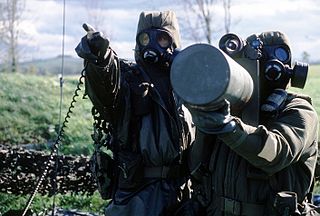
An NBC suit, also called a chemsuit, chem suit, or chemical suit is a type of military personal protective equipment. NBC suits are designed to provide protection against direct contact with and contamination by radioactive, biological or chemical substances, and provide protection from contamination with radioactive materials and all types of radiation. They are generally designed to be worn for extended periods to allow the wearer to fight while under threat of or under actual nuclear, biological, or chemical attack. The civilian equivalent is the hazmat suit. The term NBC has been replaced by CBRN, with the addition of the new threat of radiological weapons.
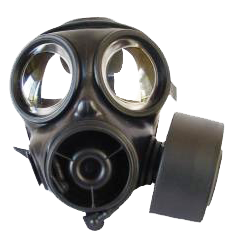
The S10 CBRN Respirator is a military gas mask that was formerly used within all branches of the British Armed Forces. Following the mask's replacement by the General Service Respirator in 2011, the S10 is now widely available to the public on the army surplus market.

The Mechanical and Chemical Industry Corporation, established in 1950, is a reorganization of government-controlled group of factories in Turkey that supplied the Turkish Armed Forces with military products.

The M17 Protective Mask is a series of gas masks that were designed and produced in 1959 to provide protection from all types of known chemical and biological agents present. The M-17 was issued to troops in the Vietnam War, and was standard issue for the U.S. Military until it was replaced by the M40 Field Protective Mask for the U.S. Army and USMC in the mid 1990s while the U.S. Air Force and U.S. Navy replaced it for the MCU-2/P Gas Mask in the mid-1980s.
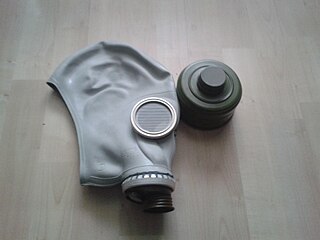
The GP-5 gas mask was historically used by the USSR for NBC protection. The mask has become a popular item in popular culture since and referenced widely in video games and films, as it is very cheap because it is the most produced gas mask ever. The GP-5 is a simple gas mask with protection around the entire head, and a single metal ringed filter for breathing. It was designed to protect against the ingress of toxic, radioactive substances and bacterial (biological) agents into the respiratory system, eyes and face of a person. It was produced in the period from 1961 to 1989. Taking into account the identified shortcomings in the operation of the civilian gas mask GP-5, it was modernized, which was called the modernized civilian gas mask model 5 - GP-5M. Gas masks GP-5 were produced three times more than the population of the Soviet Union. It was in impressive quantities in almost all industries and in civil defense shelters, sometimes it is still used as a training RPE in life safety classes, although now it is mostly replaced by the GP-7 and other soviet-era gas masks.

The use of personal protective equipment (PPE) is inherent in the theory of universal precaution, which requires specialized clothing or equipment for the protection of individuals from hazard. The term is defined by the Occupational Safety and Health Administration (OSHA), which is responsible for PPE regulation, as the "equipment that protects employees from serious injury or illness resulting from contact with chemical, radiological, physical, electrical, mechanical, or other hazards." While there are common forms of PPEs such as gloves, eye shields, and respirators, the standard set in the OSHA definition indicates a wide coverage. This means that PPE involves a sizable range of equipment. There are several ways to classify them such as how gears could be physiological or environmental. The following list, however, sorts personal protective equipment according to function and body area.

An orinasal mask, oro-nasal mask or oral-nasal mask is a breathing mask that covers the mouth and the nose only. It may be a complete independent item, as an oxygen mask, or on some anaesthetic apparatuses, or it may be fitted as a component inside a fullface mask on underwater breathing apparatus, a gas mask or an industrial respirator to reduce the amount of dead space. It may be designed for its lower edge to seal on the front of the lower jaw or to go under the chin.
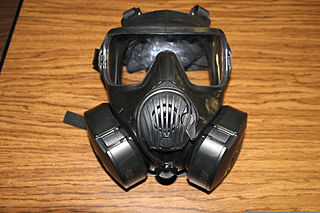
The M50 series protective mask consisting of the M50 and M51 variants, officially known as the Joint Service General Purpose (JSGPM) is a lightweight, protective mask system consisting of the mask, a mask carrier, and additional accessories. It was adopted by the U.S. military in 2006 and is manufactured by Avon Rubber.

The FM12 CBRN Respirator is a military gas mask produced by Avon Rubber.

A respirator fit test checks whether a respirator properly fits the face of someone who wears it. The fitting characteristic of a respirator is the ability of the mask to separate a worker's respiratory system from ambient air.
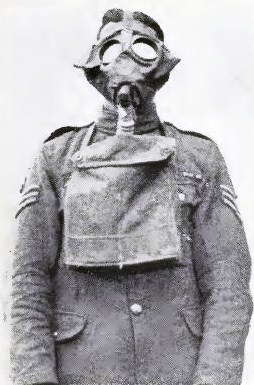
The small box respirator was the initial compact version of the recent gas mask. In late 1916, the respirator was introduced by the British with the purpose to provide reliable protection against chlorine and phosgene gas. The respirator offered a first line of defense against the gas. A later and more toxic gas, Mustard Gas, was created by Germans and was a vesicant that burnt the skin of individuals that were exposed to it. Death rates were high with exposure to both the mixed phosgene chlorine and mustard gas, however with soldiers having readily available access to the small box respirator, death rates had lowered significantly. Light and reasonably fitting, the respirator was a key piece of equipment to readily protect the respiratory health of soldiers on the battlefield.

An N95 filtering facepiece respirator, commonly abbreviated N95 respirator, is a particulate-filtering facepiece respirator that meets the U.S. National Institute for Occupational Safety and Health (NIOSH) N95 classification of air filtration, meaning that it filters at least 95% of airborne particles. This standard does not require that the respirator be resistant to oil; another standard, P95, adds that requirement. The N95 type is the most common particulate-filtering facepiece respirator. It is an example of a mechanical filter respirator, which provides protection against particulates but not against gases or vapors. An authentic N95 respirator is marked with the text "NIOSH" or the NIOSH logo, the filter class ("N95"), a "TC" approval number of the form XXX-XXXX, the approval number must be listed on the NIOSH Certified Equipment List (CEL) or the NIOSH Trusted-Source page, and it must have headbands instead of ear loops.
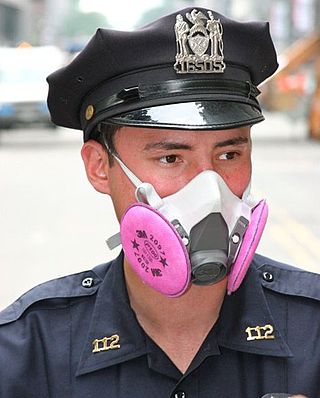
Elastomeric respirators, also called reusable air-purifying respirators, seal to the face with elastomeric material, which may be a natural or synthetic rubber. They are generally reusable. Full-face versions of elastomeric respirators seal better and protect the eyes.



















